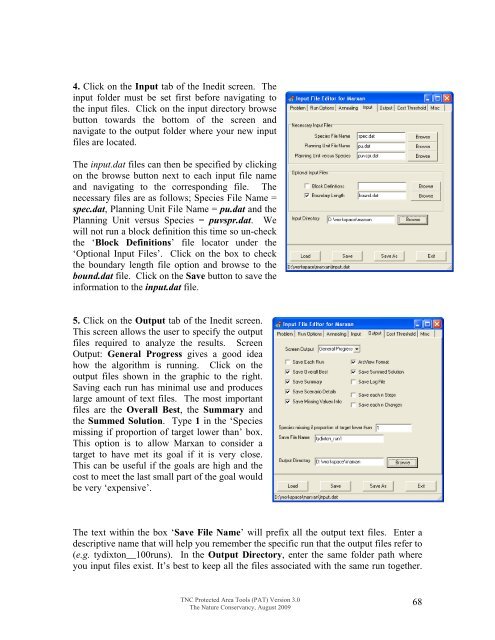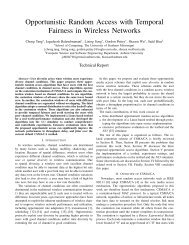Download the Tutorial
Download the Tutorial
Download the Tutorial
Create successful ePaper yourself
Turn your PDF publications into a flip-book with our unique Google optimized e-Paper software.
4. Click on <strong>the</strong> Input tab of <strong>the</strong> Inedit screen. Theinput folder must be set first before navigating to<strong>the</strong> input files. Click on <strong>the</strong> input directory browsebutton towards <strong>the</strong> bottom of <strong>the</strong> screen andnavigate to <strong>the</strong> output folder where your new inputfiles are located.The input.dat files can <strong>the</strong>n be specified by clickingon <strong>the</strong> browse button next to each input file nameand navigating to <strong>the</strong> corresponding file. Thenecessary files are as follows; Species File Name =spec.dat, Planning Unit File Name = pu.dat and <strong>the</strong>Planning Unit versus Species = puvspr.dat. Wewill not run a block definition this time so un-check<strong>the</strong> ‘Block Definitio ns’ file locator under <strong>the</strong>‘Optional Input Files’. Click on <strong>the</strong> box to check<strong>the</strong> boundary length file option and browse to <strong>the</strong>bound.dat file. Click on <strong>the</strong> Save button to save <strong>the</strong>information to <strong>the</strong> input.dat file.5. Click on <strong>the</strong> Output tab of <strong>the</strong> Inedit screen.This screen allows <strong>the</strong> user to specify <strong>the</strong> outputfiles required to analyze <strong>the</strong> results. ScreenOutput: General Progress gives a good ideahow <strong>the</strong> algorithm is running. Click on <strong>the</strong>output files shown in <strong>the</strong> graphic to <strong>the</strong> right.Saving each run has minimal use and produceslarge amount of text files. The most importantfiles are <strong>the</strong> Overall Best, <strong>the</strong> Summary and<strong>the</strong> Summed Solution. Type 1 in <strong>the</strong> ‘Speciesmissing if proportion of target lower than’ box.This option is to allow Marxan to consider atarget to have met its goal if it is very close.This can be useful if <strong>the</strong> goals are high and <strong>the</strong>cost to meet <strong>the</strong> last small part of <strong>the</strong> goal wouldbe very ‘expensive’.The text within <strong>the</strong> box ‘Save File Name’ will prefix all <strong>the</strong> output text files. Enter adescriptive name that will help you remember <strong>the</strong> specific run that <strong>the</strong> output files refer to(e.g. tydixton__100runs). In <strong>the</strong> Output Directory, enter <strong>the</strong> same folder path whereyou input files exist. It’s best to keep all <strong>the</strong> files associated with <strong>the</strong> same run toge<strong>the</strong>r.TNC Protected Area Tools (PAT) Version 3.0The Nature Conservancy, August 200968
















